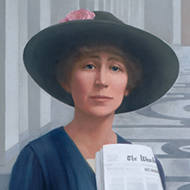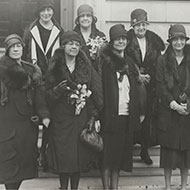Jeannette Rankin’s Historic Election: A Century of Women in Congress
When Jeannette Rankin took the oath as a U.S. Representative on April 2, 1917, Congress and the country took note. Nearly 7,000 Representatives had served before Rankin—all had been men. Her remarkable election in 1916 occurred four years before women had the right to vote nationally, and blazed a path followed by more than 300 women to date. To celebrate Rankin’s milestone, this page provides ready access to teaching materials, oral histories, biographies, documents, artifacts, that tell the 100-year history of women in Congress.
Featured
Women in Congress
Rankin was the first of many women to serve in Congress as U.S. Representatives, Senators, or Delegates. To learn more about each of them, browse this up-to-date web publication based on the book, Women in Congress, 1917–2006.
For Educators
Explore a series of lesson plans, based on the publication Women In Congress, that offer activities for students using primary sources.










